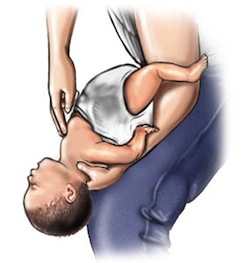How to Prevent Choking in Babies
March 15, 2012 | in Nannies
 Nothing is scarier than having your baby or the baby in your care in immediate danger. As much as we worry about all the things that could happen, facing them in a critical moment is even worse. The best way to calm your fears against the unknown is to educate yourself on what to do in every situation and taking preventative measures.
Nothing is scarier than having your baby or the baby in your care in immediate danger. As much as we worry about all the things that could happen, facing them in a critical moment is even worse. The best way to calm your fears against the unknown is to educate yourself on what to do in every situation and taking preventative measures.
Why Babies Choke
Babies and small children are notorious for sticking anything and everything in their little mouths. As much as you baby and
child proof and remove small items from the environment that they might get their chubby hands on, they always seem to find something that was missed. But although foreign objects are a real concern, the main cause of choking for infants and small children is food. According to the American Academy of Pediatrics, one child dies every five days in the U.S. from choking on food. The best way to avoid choking on food in babies is to follow a few safety tips: -Do not switch to solid foods too soon. Make sure your child has the motor skills to handle swallowing solid foods. Babies should be able to sit well when supported, have head control, have a growing appetite, show interest in eating food and have a diminishing extrusion reflex before introducing solid foods. While most children are ready to eat solid foods by four to six months of age, many pediatricians recommend waiting until a child is six months old before introducing solid foods. -Avoid distracted eating. One of the reason infants choke even on liquids is that they become distracted during feedings. Make feeding time a calm and relaxing experience, free from distractions. When in a room where adults are chatting, the television is on and people are walking around, a baby is likely to be distracted and to lose focus on eating. -Serve foods that are appropriate in size and texture. Once you’ve moved on from pureed foods, you’ll want to be sure you are serving soft, bite-sized foods, Make sure all solid foods are less than ½” in diameter and stay away from slippery or dry hard-to-chew foods. Popcorn, hot dogs, peanut butter and grapes are choking hazards for babies
and young children. Kitchen shears can help parents and nannies cut foods easily into appropriate sizes. –Remove hidden hazards from the home. Before your baby is mobile, you’ll want to crawl around on the floor to experience the world from his vantage point. Look for items like rubber ends of door stoppers or splintering chair legs that could pose a choking risk. Remove small toys and other potential choking hazards from your baby’s environment. Even with the best prevention, choking can still happen. Knowing what to do in a choking emergency is the best prevention of brain damage and death. The faster the object is removed, the less chance any permanent harm will come from the incident. Make sure all caregivers for your child have the proper CPR and choking first aid training, including all family members. It could literally be a matter of life and death.
← 10 Fun Rhyming Games to Play With Kids | 10 Reasons to Introduce Your Nanny to Your Neighbors →Comments are closed.
Search for nanny jobs
in your zipcode:






